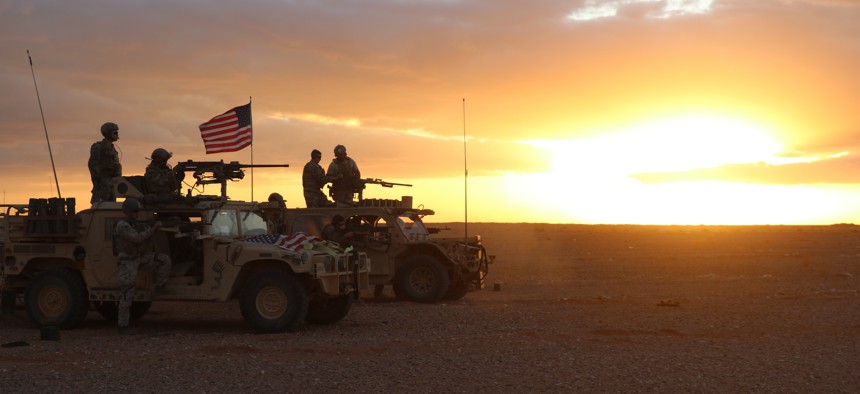
Members of 5th Special Forces Group conducting 50. Cal Weapons training during counter ISIS operations at Al Tanf Garrison in southern Syria in November 2017. DOD photo / Staff Sgt. Jacob Connor
The Administration Must Explain Its Use-of-Force Theories. Today.
That's not just a good idea; it's the law. A report to Congress is due on Monday.
Too many questions remain unanswered about the Trump administration’s view of its authority to use military force, thanks to — among other things — last April’s missile strikes on a Syrian airfield, October’s operation in Niger that led to the deaths of four U.S. servicemembers, the recent talk of a “bloody-nose” strike against North Korea, the continued military detention of a U.S. citizen in Iraq, the prospect of a long-term U.S. military presence in Syria, and the reported loosening of the rules for targeting suspected terrorists.
This week, the administration has an important opportunity to answer these questions. And by doing so, it would both demonstrate its commitment to transparency and strengthen U.S. national security.
A little-known provision in the annual defense authorization bill requires President Trump to provide to the relevant committees in Congress a report describing the legal and policy bases for its use of military force and related national security operations, including its detention, interrogation, and prosecution policies. The report must provide not only the governing laws and policies as the Trump administration interprets and applies them, but also explain—and back up with a legal, policy, and factual rationale—any changes since Trump took the reins from Obama. On top of this critical one-time report — which is due Monday, March 12 — President Trump and all subsequent presidents must continue to inform Congress of changes.
This requirement is a very big deal for those who believe that transparency regarding the use of military force is essential to democracy, the rule of law, human and civil rights, and effective congressional oversight. As a former State Department lawyer recently noted, it could be “one of the most important steps toward increasing transparency in U.S. national security policy in decades.”
By fulfilling the reporting requirement, the Trump administration would also increase the legitimacy of U.S. actions and therefore strengthen U.S. national security. Explaining the legal and policy basis for U.S. military operations rebuts propaganda from terrorist groups and hostile nations and strengthens support from allies and local populations, which is critical to the achievement of U.S. objectives.
To realize these benefits, the Trump administration should provide this information to the American people, not just Congress. We know such transparency is possible because prior to the enactment of the statutorily-mandated reporting requirement, the Obama administration voluntarily released a 66-page report detailing the legal and policy basis for its use of military force. In fact, the congressional requirement is based on Obama’s report. The Obama administration was widely praised for this report not because everyone agreed with its policies, legal interpretations, or approach to national security issues, but because this thorough and public report enabled an informed discussion, whatever one’s views.
The lack of such explanation from the Trump administration at critical points this past year has, by contrast, stifled such discussion and debate. For example, it’s been nearly five months since the President reportedly signed off on new rules for drone strikes and other lethal operations against suspected terrorists outside of war zones, yet it hasn’t released the new policy or an explanation of the changes. And it’s been nearly a year since the strikes against a Syrian airfield in response to a chemical weapons attack yet calls for a thorough explanation of the legal basis for those strikes have gone unanswered.
Let’s hope we soon learn the answer to the these questions, and to many others. The answers will likely invite more questions, and certainly some criticism, but that’s democracy. And the matter at hand couldn’t be more important: when and how the president is permitted to kill people, or otherwise use military force. Let the debate begin.
NEXT STORY: A Trump-Kim Summit: 'Why the Hell Not?'



